When I started learning how to improvise, the one thing I really wanted to figure out was how to create improvised lines like my musical heroes…
Listening to players like Miles, Bird, Coltrane, and countless others, I wanted to learn exactly which notes to choose on a chord and how to turn these notes into a melodic phrase…
What was their secret for creating effortless musical lines over the exact same chord progressions I was trying to learn??
Like many players, I jumped in with the resources I had available at the time – scales & chords. Maybe I could find a formula that would allow me to move easily from chord tone to chord tone over a chord progression…

Perhaps the hidden secret to creating a seamless line through the chords lay in guide tone lines, chromatic passing tones, enclosures, or some sort of special scale?
Yet, no matter how much I practiced, I was still lost and stuck thinking about individual notes as the chords flew by. I felt like I was missing an essential skill that would finally allow me to navigate chords in a melodic way.
Along the way I even studied solo transcriptions from great players, looking at specific chords and the notes they chose:
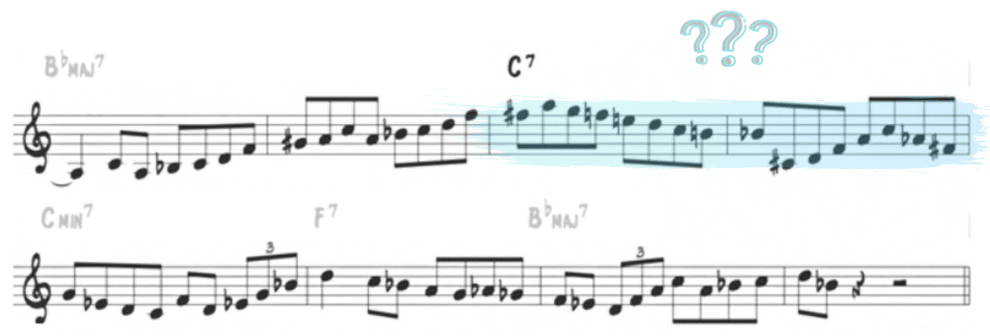
I would isolate a single line over a chord searching for a system or technique for creating lines, but in my effort I failed to consider the other chords in the progression and how this relationship affected the line.
Like many musicians, I had tunnel vision when it came to jazz improvisation – I was so worried about the notes on top of each chord and how to connect them, that I ignored the larger harmonic relationships happening in the tune.
And if this scenario sounds familiar, you’re not alone…
Coming from the typical jazz education resources, it can seem like the most important thing to learn are scales and chords…that if you practice this stuff enough, there will eventually be a “eureka” moment where everything clicks.
Unfortunately, this never seems to happen and often leaves you with the same frustrating questions and roadblocks I encountered above when tackling chord progressions.
The surprising solution however, goes back to one skill hiding in plain sight – a mastery of harmony.
Music Theory isn’t Harmony
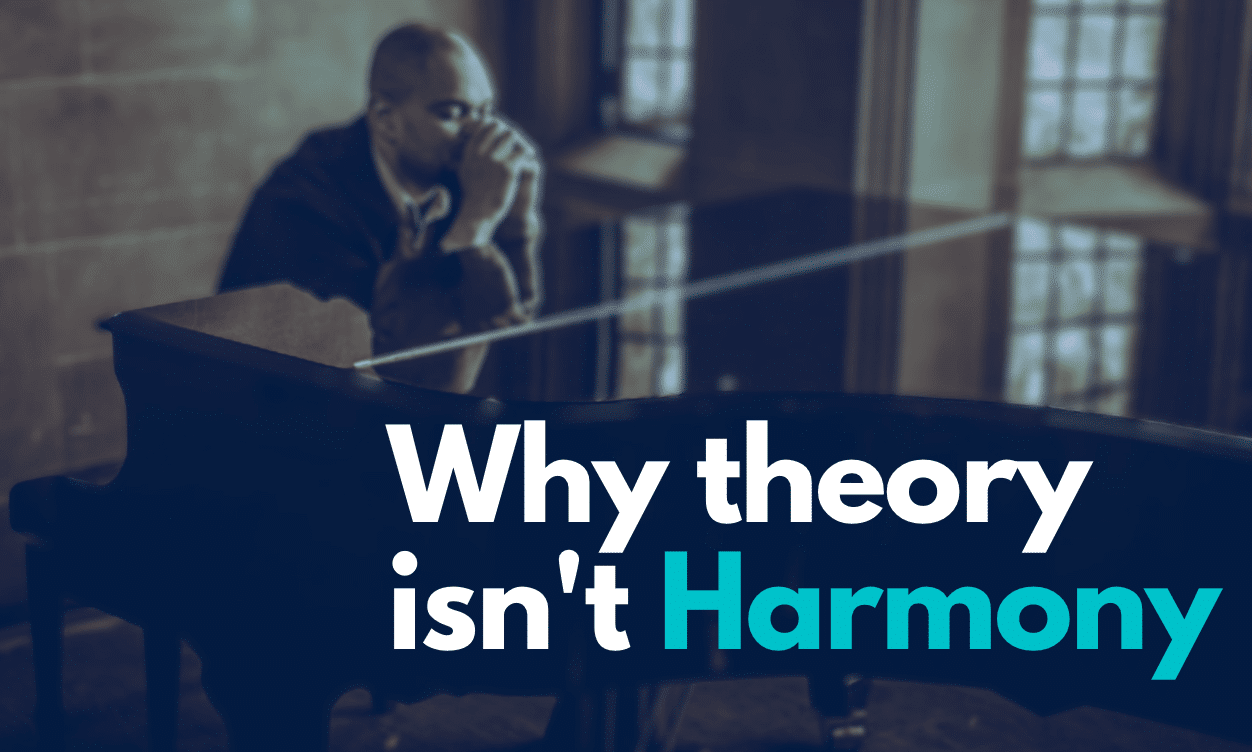
Before we go any further, it’s important to understand what harmony is not…
If you’re reading this, you’re probably thinking as I often did, “Hold on a second, I’ve studied music theory and that means I know the essentials of harmony!”
And this is the mindset many musicians take into their solos, using the building blocks of music theory to approach chords…
It makes sense, any proficient player needs to know things like intervals, triads, scales and modes, rhythm, chord types, the circle of 5ths, and key signatures, etc.
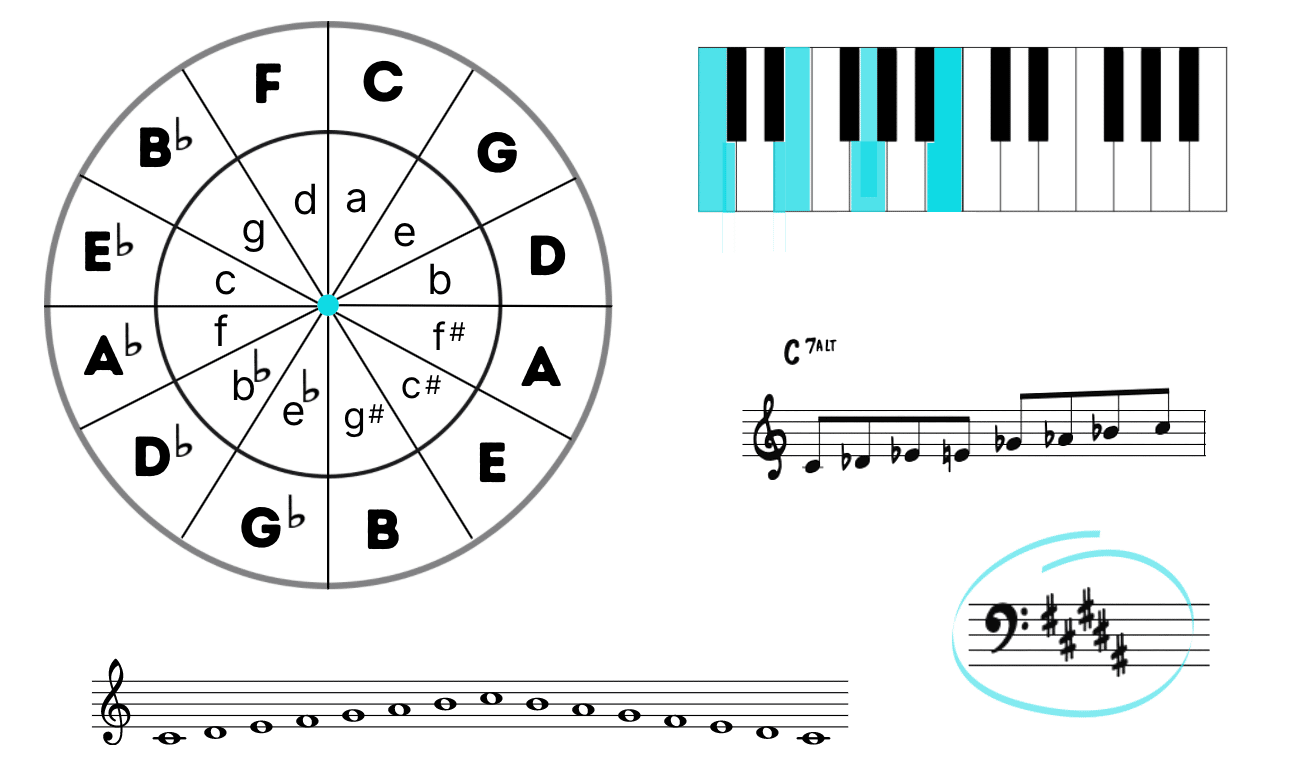
However, these are just the raw materials that make up any style of music, not the actual “music” itself. And for someone that wants to improvise creatively over a tune, it’s just the very first step.
In this context, harmony often gets reduced to roman numerals and a few rules – an analytical approach rather than a framework for navigating tunes in a musical way. The expectation being that you can simply learn the definitions and jump right into a chord progression, improvising over it with ease.
But as you may have noticed, this isn’t exactly the case!
The trouble happens when these theory definitions become the main tools for improvisation, a substitute for digging deeper and actually learning functional harmony and the musical language of navigating it.
It’s like putting a band-aid on the musical challenges of a tune – memorizing information without the “why” behind it or how to use it in a musical way.
This is why you see countless players using scales to get through a progression or using the dorian mode for every minor chord in a tune. Methods that are often incorrect or unrelated to the actual harmony happening in the progression.
And it’s all because a serious study of harmony is overlooked. The truth is, you can have a strong grasp of music theory and still run into issues with:
- Creating longer musical phrases over tunes
- Connecting chords or ideas in your solo
- Memorizing the changes to jazz standards
- Making sense of a chord progression from start to finish
- Wondering where certain chords come from & what to play over them
- Confused as to why the same tune can have different chord changes
If these ring a bell, it’s time to go back and focus on the missing harmonic element in your musical approach.
Defining “harmony”
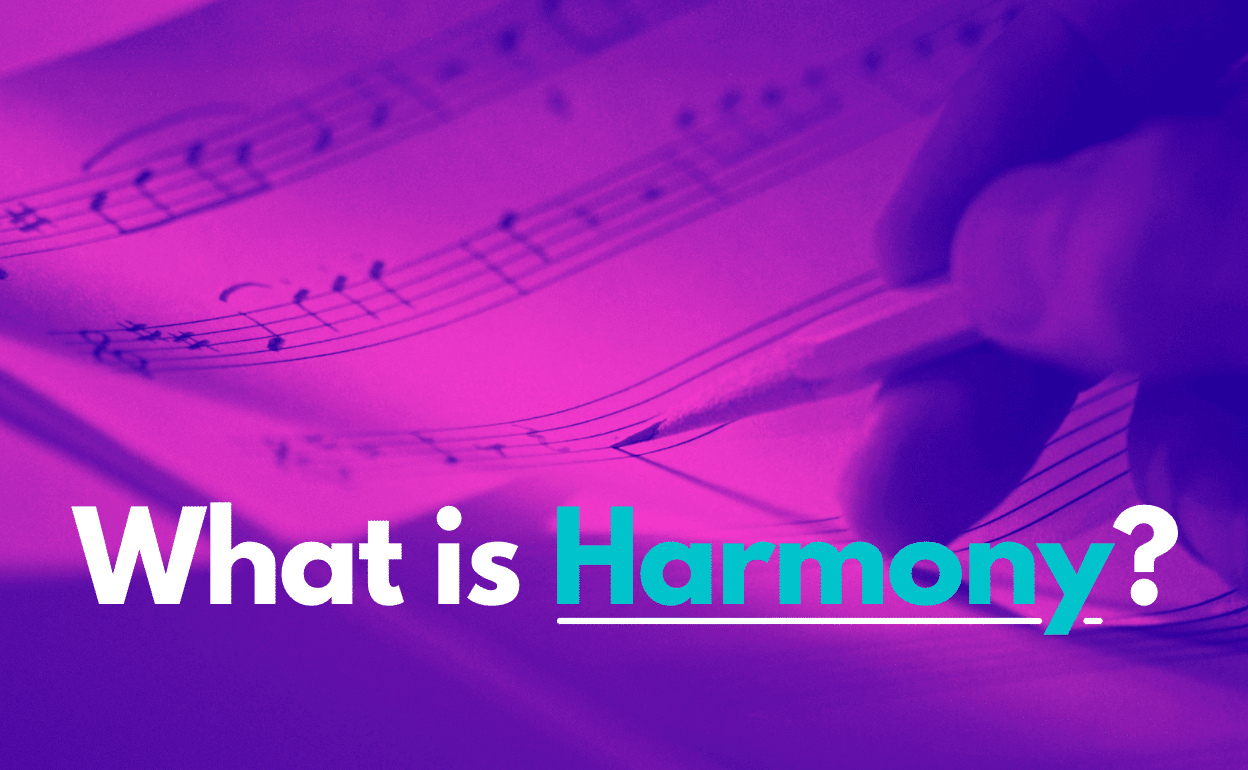
So what exactly is harmony and why should you spend time studying it?
The dictionary defines harmony as…
“The combination of simultaneous musical notes (in a chord); the structure of music with respect to the composition and progression of chords.”
Harmony is not only the notes that make up a chord, but how these chords function within a musical context. And this is precisely the kind of knowledge that we need to focus on as improvisers…
You see, it’s one thing to know the definition of diatonic chords (I, ii, iii, etc.) in a classroom setting, but it’s something else entirely to become fluent in harmony – mastering how chords function & interact in the jazz standards we play.
For example, take the diatonic chords in the key of Eb Major that you would learn in a theory context:

By memorizing and practicing these diatonic chords, it’s assumed that you know the key and can play any progressions that might arise from this framework.
Now take a common chord progression you might find in a jazz tune in the key of Eb Major:

In this progression, you’ll immediately notice that there are non-diatonic chords operating within the home key. For jazz musicians, each of these chord relationships is not only common, but an essential part of playing in the larger key of Eb.
Both examples are in the same key, but coming from the world of diatonic chords, it’s hard to see how the two connect…and this is exactly why so many players that “know” theory have trouble creating musical phrases over jazz standards.
There’s a disconnect between the information of a key (the key signature, major scale, and diatonic modes) and the actual practice or jazz tradition of harmonic movement within that key.
Harmony isn’t just knowing the notes of a chord, it’s mastering the function and movement of each chord within a larger key. Understanding where a chord comes from and where it’s going, how the progression fits together. This is the “jazz theory” that you really need to know.

To improve you need to expand your definition of harmony beyond the confines of music theory and go a step further, learning how harmony functions in Major and minor keys.
Enter Functional Harmony…

As a creative musician the goal is to develop a deep understanding of “functional harmony” as it’s found in the jazz repertoire…
You see, there’s a tradition of harmonic relationships, chord movement, and common substitutions that every great improviser knows and has studied. This is why you hear master improvisers playing seamless lines and phrases over any jazz standard.
…they aren’t approaching a tune as individual chords or scales, they are focusing on harmonic function – the movement between chords.
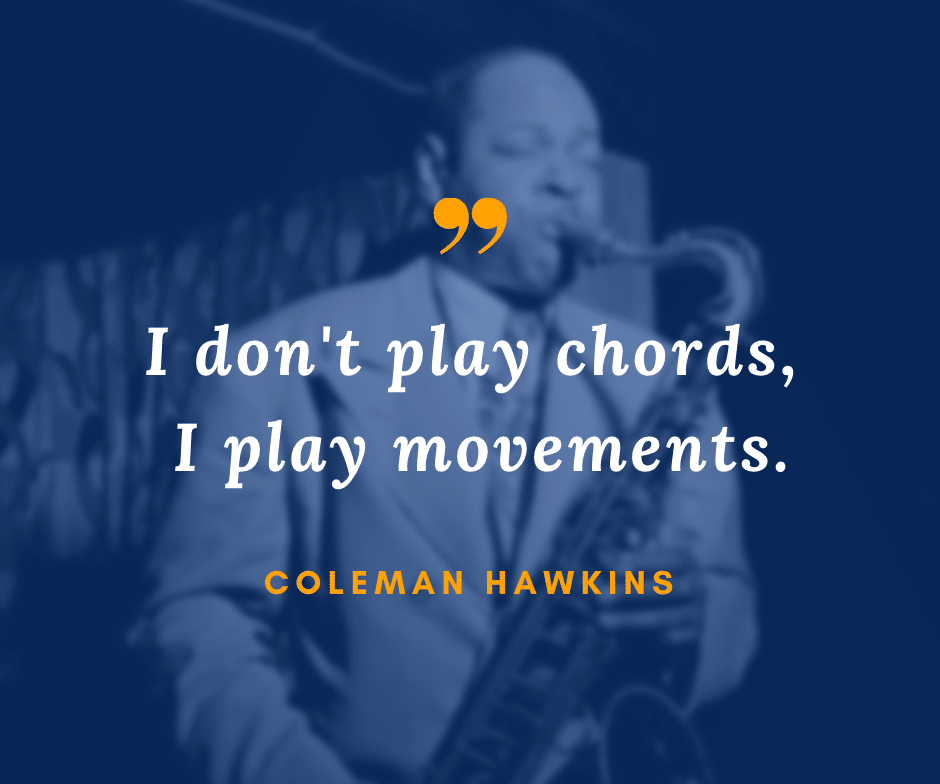
The trick is changing the way you approach chord progressions, switching from a theory mindset with isolated chords and scales to one of harmonic relationships operating within the universe of a larger key.
As the great Coleman Hawkins says, it’s not just the chords themselves that you need to worry about, it’s the movement between these chords that is crucial for jazz improvisation.
To improve your solos you need to start focusing on the harmonic relationships within tunes – mastering the common harmonic elements that pop up in nearly every jazz standard.
In a theory class it might be enough to learn a key signature, the diatonic chords, and a few simple progressions and say you “know” a key, but for improvisers, understanding harmony and “knowing a key” is a little more complex.
In the jazz repertoire, there’s an established relationship of chord movement within a home key that you need to master – not just in theory, but in practice.
This begins with the diatonic harmony in a major key, but quickly expands beyond the traditional diatonic chords to include borrowed harmony from adjacent diatonic chords…
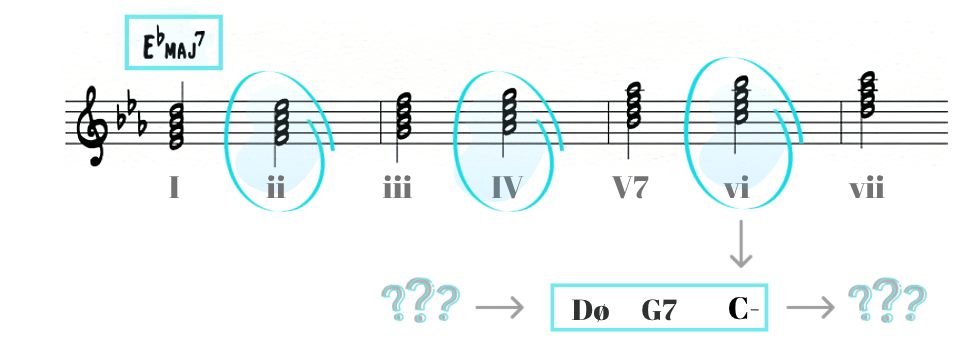
Lucky for us, these harmonic elements aren’t random or unlimited. There are a finite number of essential elements of jazz harmony that you need to know in any key. To master jazz harmony you need to be able to:
- Learn and define these common harmonic elements
- Understand how each functions and relates to the home key
- Be able to quickly identify them in tunes and common progressions
- Know how they can be substituted or the variations you’ll find them in
- And develop language and techniques for improvising over them
This is functional harmony that you can actually use in your solos!
Your responsibility as an improvisor is isolating and identifying specific sounds within a key that are arrival points or destinations that are tonicized and learning the common ways of arriving at these spots and resolving away from them.
And this skill can fundamentally improve the way you approach the harmony in jazz standards and create melodic lines…
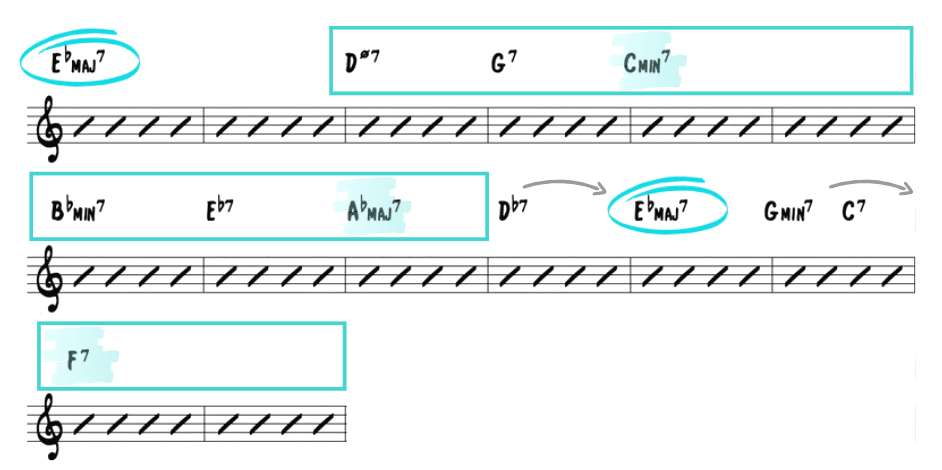
Each major key has its own “harmonic universe” and you need to be able to easily recognize these common chord relationships and movements that pop up over and over again in the jazz repertoire.
Remember, Harmony evolves

One thing we often forget is that the tunes & progressions we play today are the byproduct of a long musical process…
Basic chord movement and simple tunes evolved over time, undergoing countless iterations, substitutions, and experimentation…each generation of new musicians adding another layer of musical possibility to the harmonic palette.
And this is the thing that makes a solid understanding of harmony so crucial to the art of improvisation. A tune isn’t just a collection of chords that you memorize, there is a specific reason, relationship, history, and function for each chord in the tune.
As musicians today, we’re starting from the tail end of a sophisticated harmonic evolution. Tackling harmony that’s passed through the hands of Louis Armstrong, Charlie Parker, Thelonious Monk, John Coltrane, Wayne Shorter, and countless other masters.
Most theory classes prepare us for simple diatonic progressions, not for improvising over the harmonic universe that we find in the modern jazz repertoire!
Over time, simple progressions like this one:

Evolve into something that looks completely different, but is nonetheless directly related:

And if you haven’t studied harmony, trying to solo over this progression is like walking into the final exam at the end of the year after missing all of the classes.
To truly improvise effectively over today’s tunes, you need to go back and understand the path that led to these chord progressions, study how these tunes were built, piece by piece, and how they evolved over time.
Any holes in your understanding of basic harmonic function is going to make improvising over modern jazz standards even more frustrating!
Master Jazz Harmony Today
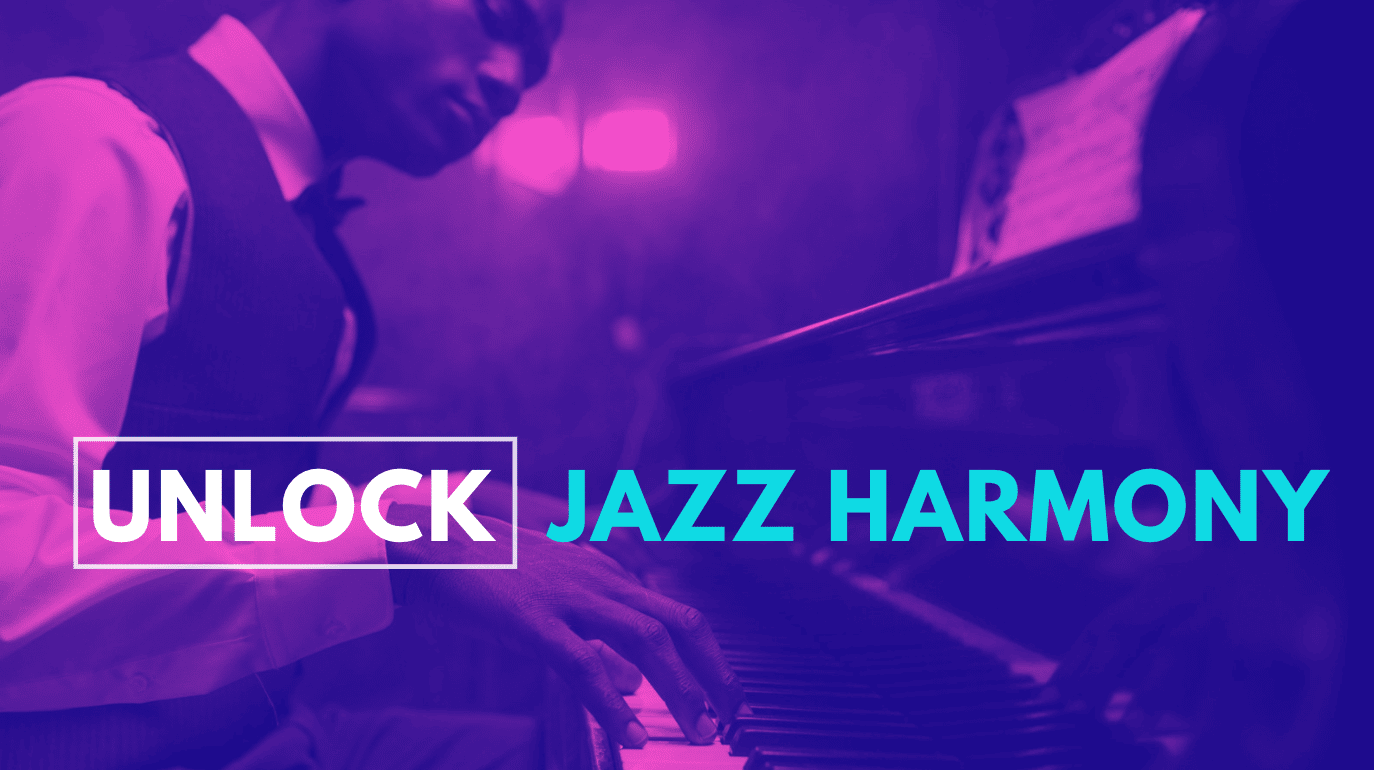
So what is the next step on your harmonic journey?
The truth is, making sense of the harmony that you encounter in jazz standards can be a big undertaking…
But if you have the right tools, this process doesn’t have to be confusing or time consuming. And with a little study and practice you can drastically improve your approach to improvising over jazz standards.
That’s precisely why we developed a brand new course that will allow you to master jazz harmony once and for all – Jazz Theory Unlocked.
In this course we’ll give you an easy to understand system that will help you ingrain the essential elements of jazz harmony and discover how jazz tunes really work.
Inside you’ll find:
- 60 animated video lectures
- 15 step-by-step lessons
- The Framework of the 9 Elements
- A breakdown of Diminished Chords
- and much more!
If you’ve been confused with chord progressions, struggling to connect chords in your solos, or frustrated with playing tunes, this course is for you.
Go get your copy of Jazz Theory Unlocked today and unlock your harmonic potential!











